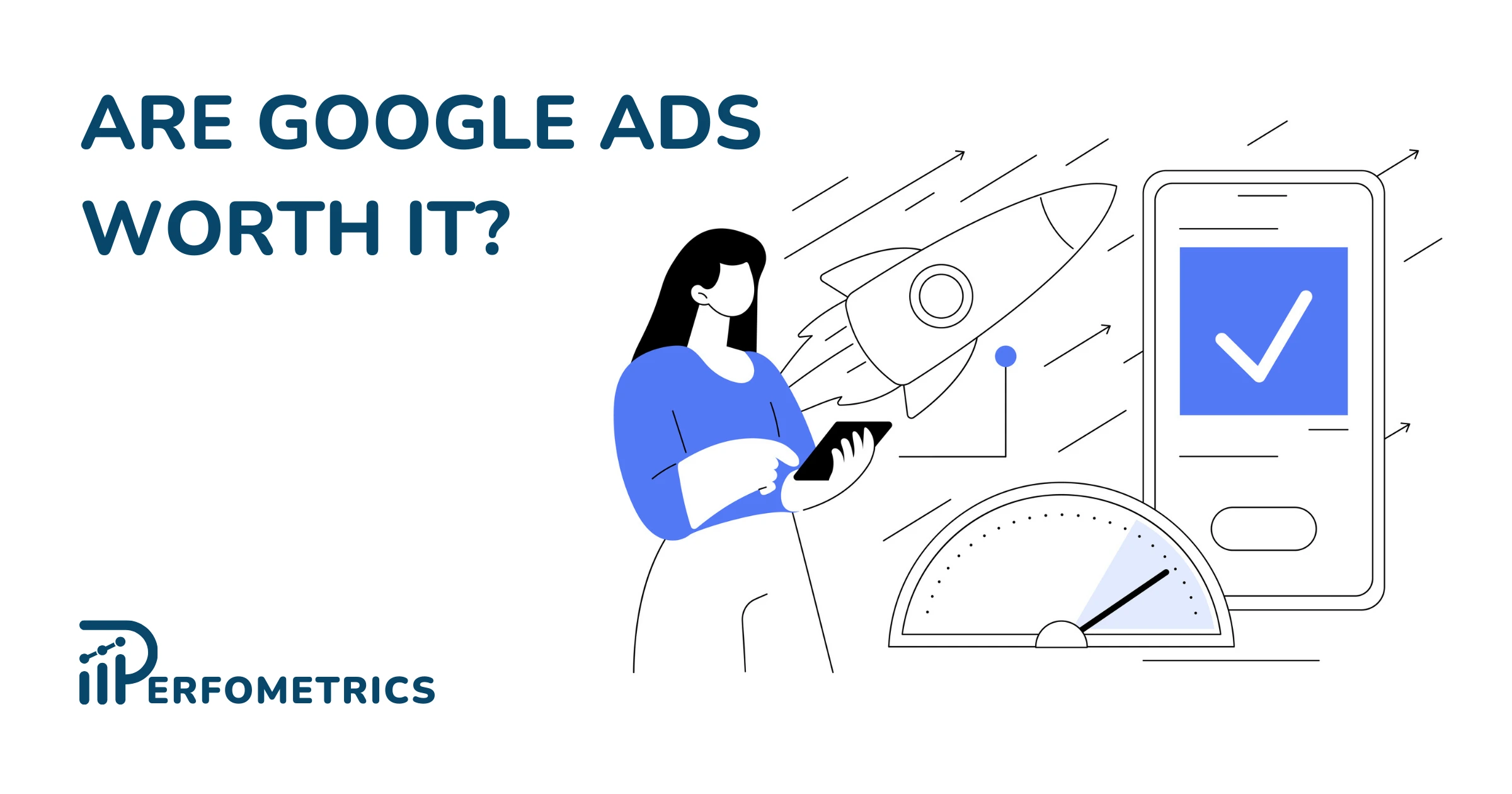Are Google Ads Worth It? – Learn the Pros and Cons

Are Google Ads worth it? Considering the numerous advantages they offer, it is safe to say that Google Ads can be highly effective and profitable for small and big businesses when used correctly. However, it also depends on various factors such as the nature of your business, your marketing goals, expertise, and your budget.
What Are Google Ads?
Google Ads, formerly known as Google AdWords, is an online advertising platform developed by Google. It allows businesses to create and display ads on various Google platforms, such as search result pages, YouTube videos, and partner websites. This powerful advertising tool operates on a pay-per-click (PPC) basis, meaning advertisers only pay when someone clicks on their ad.

Google Ads, formerly known as Google AdWords, is a powerful online advertising platform developed by Google. It provides businesses with a unique opportunity to showcase their products and services to a vast global audience. With 89.3 billion visits every month (Similarweb, 2022), it’s no wonder that Google Ads is a significant player in the digital advertising world.
Launched in the year 2000, Google Ads has since grown to become the largest digital advertising platform globally, accounting for a substantial portion of Google’s revenue. This platform allows advertisers to bid on specific keywords and display their ads at the top of Google’s search results, on relevant websites, and within various Google services. It’s a highly effective tool for businesses looking to increase their online visibility, drive traffic, and boost conversions.
How Successful Are Google Ads?
With over 91% global search market share (GS Statcounter, 2023), Google has an unparalleled ability to connect businesses with potential customers at any given moment. Moreover, Google Ads allow advertisers to target specific keywords and demographics, ensuring that their ads are shown to individuals actively searching for products or services related to their business.
Google Ads’ highly targeted approach increases the chances of conversion and maximizes the return on advertising spend. Google’s sophisticated algorithms analyze user behavior and intent, enabling advertisers to optimize their campaigns based on valuable insights. Google Ads offers a range of ad formats, from text-based search ads that appear on top of search engine results pages (SERPs) to visually engaging display ads and video ads on YouTube. This allows advertisers to choose the best format for their target audience and campaign objectives.

Google Ads can be quite successful and effective for businesses. Here are some statistics that highlight their success:
- People who click on ads are 50% more likely to make a purchase.
- Online ads increase brand awareness by 80%.
- 46% of clicks go to the top three paid ads in search results.
- 35% of users purchase a product within 5 days of searching for it on Google.
- 90% of consumers say ads influence their purchase decisions.
- 75% of users say paid search ads make it easier to find information.
- The average conversion rate for Google Ads is 75%; for the Google Search Network, it’s 17%, and for the Google Display Network, it’s 46%.
These statistics suggest that Google Ads can be a powerful tool for increasing visibility, driving traffic, and converting leads into customers. However, the success of Google Ads can vary depending on factors such as the industry, the quality of the ad, and the relevance of the ad to the user’s search.
Pros and Cons of Using Google Ads
5 Reasons to Invest in Google Ads
- Highly Targeted Audience: Google Ads is effective in reaching a highly targeted audience through advanced targeting options, such as keyword targeting, demographic targeting, and location targeting. This level of specificity allows you to maximize your ad spend by focusing on individuals who are most likely to convert into customers.
- Immediate Results: Unlike traditional marketing methods that require time for campaigns to launch and generate traction, Google Ads provides businesses with an opportunity for instant visibility. Once a campaign is set up and approved, ads can start appearing on search engine results pages (SERPs) within minutes. This means that you can quickly generate traffic, leads, and sales without waiting for organic search rankings or other forms of digital marketing efforts to take effect.
- Comprehensive Tracking: Google Ads provides robust tracking and measurement tools for real-time monitoring of key metrics. You can monitor key metrics such as impressions, clicks, conversions, and return on investment (ROI). This level of data granularity enables you to optimize your campaigns continuously by identifying what works best and making data-driven decisions to improve overall campaign performance.
- Versatile Ad Formats: Google Ads also offers various ad formats beyond traditional text ads, such as display ads and video ads. These formats allow businesses to engage with potential customers through visually appealing content or interactive multimedia experiences. This versatility enables advertisers to create compelling advertisements that stand out from competitors while conveying their brand message effectively. The advantages of using Google Ads include highly targeted audience reach, immediate visibility in search results pages, insightful tracking and measurement tools for optimizing campaign performance continuously, and versatile ad formats beyond standard text ads.
- Control and Optimization: This level of control empowers advertisers to test different approaches and optimize their campaigns for maximum results. Furthermore, Google Ads provides robust analytics and tracking capabilities that enable businesses to measure the effectiveness of their campaigns accurately. Through detailed performance reports, advertisers can gain insights into key metrics such as click-through rates (CTR), conversion rates, cost-per-click (CPC), and return on ad spend (ROAS). This data-driven approach allows for constant optimization and fine-tuning of the campaign strategy. Advertisers can identify what aspects are working well and make informed decisions about where adjustments need to be made.
These are only a few, check out our article detailing more on the benefits of using Google Ads. This makes it a valuable advertising platform for businesses looking to enhance their online presence, generate leads, and drive sales. However, it is essential to weigh these advantages against the potential disadvantages before deciding if Google Ads is worth it for you.
4 Reasons Google Ads Might Not Be Worth It
- High Costs: The bidding system used by Google Ads means that you could end up paying a significant amount of money for each click on your ad. This can quickly eat into your budget, especially if you’re in a competitive industry where keywords are more expensive. Smaller businesses with limited budgets may struggle to compete effectively against larger companies with substantial marketing budgets, particularly in highly competitive sectors.
- No Guarantee of Conversions: Despite robust targeting options, not every click translates into a conversion or purchase. It’s crucial to carefully monitor and optimize your campaigns to ensure that you are attracting qualified leads who are likely to convert into customers. If not managed properly, this could lead to wasted ad spend and lower return on investment (ROI).
- Unclear Objectives: Before investing in any advertising campaign, it’s crucial to have clear objectives and measurable goals in mind. Without specific targets, it becomes challenging to evaluate the effectiveness and success of your Google Ads campaigns. If you’re unsure about what you want to achieve or how to measure success, consider taking some time to define your objectives before deciding whether or not Google Ads is worth pursuing.
- Ongoing Management: Google Ads demands persistent attention and adjustments to maximize its effectiveness. To ensure that your Google Ads campaigns deliver the desired results, you must continuously monitor their performance and make necessary modifications such as adjusting bids, refining ad copy, and optimizing targeting options. Without this proactive management, you risk your ads becoming less relevant over time, leading to a decline in their performance.
It’s important to carefully consider these factors and weigh them against your specific goals and circumstances before deciding if Google Ads is a suitable investment for your business.
Unlocking the Full Potential of Your Google Ads Investment
Once you have decided to invest in Google Ads, it is crucial to understand how to unlock the full potential of your investment.
Simply launching a campaign and hoping for the best will not yield optimal results. Instead, implementing a strategic approach will maximize your chances of success and make your Google Ads investment truly worthwhile.
Here are some points to consider when creating a Google Ads campaign:
- Focus on correct Keyword Optimization in Google Ads and choosing the right target Audiences for your Google Ads campaigns
- Create effective Ad Copy and use every appropriate Google Ads Ad Extension
- Select the right Google Ads Campaign Type: Search, Discovery (Demand Gen), Performance Max, Video, etc.
- Choose the correct Bidding Strategy for the Google Ads campaign: Target CPA, Target ROAS, Max Clicks, etc.
- Perform continuous performance monitoring and analysis
To measure the success of your Google Ads campaigns, you can make use of the columns and segments available in Google Ads to following some key metrics:
- Return on Investment (ROI): This is calculated by comparing the cost of your ads to the revenue they generate.
- Cost per Click (CPC): This measures how much you pay for each click on your ads.
- Optimization Score: Google Ads provides an optimization score that suggests how well your campaign is set to perform and what tweaks you can make to improve performance.
- Goal Conversions: You can track goal conversions in Google Analytics to measure the success of your marketing campaign.
- Traffic Source: Analyzing the source of your traffic can help you understand which channels are most effective.
Remember, these numbers should be tracked over time to understand trends and make necessary adjustments. Also, Google Ads provides various reporting tools and features that can help you analyze your advertising campaign performance effectively. It’s also possible to run experiments within your Google Ads account to test different strategies and check performance.
Note: The success of a campaign can vary depending on factors such as industry competition, budget allocation, and the quality of the ad itself. Therefore, it’s important to continuously monitor and adjust your campaigns based on these metrics and insights.
By implementing these strategies and best practices in Google Ads, and constantly refining your approach, you can unlock the full potential of your Google Ads investment. Remember that success with Google Ads is not guaranteed overnight, but with strategic planning, continuous optimization, and a keen eye on performance metrics, you can maximize the effectiveness and profitability of your campaigns.
Our Final Thoughts
Ultimately, Google Ads have proven themselves as a valuable tool in modern digital marketing strategies. The potential they hold for driving targeted traffic to websites and generating sales cannot be underestimated.
While there are certainly disadvantages to using Google Ads, such as the potential for high competition and rising costs, these challenges can be overcome with careful strategizing and optimization. By continually monitoring and refining your campaigns based on performance data, you can maximize the effectiveness of your ads while minimizing unnecessary expenses.
With proper planning, execution, and ongoing optimization efforts, businesses stand a strong chance of harnessing the power of Google Ads to achieve their marketing objectives effectively. So if you’re wondering whether Google Ads are worth it or not – when implemented wisely – they can undoubtedly pave the way towards business success.



